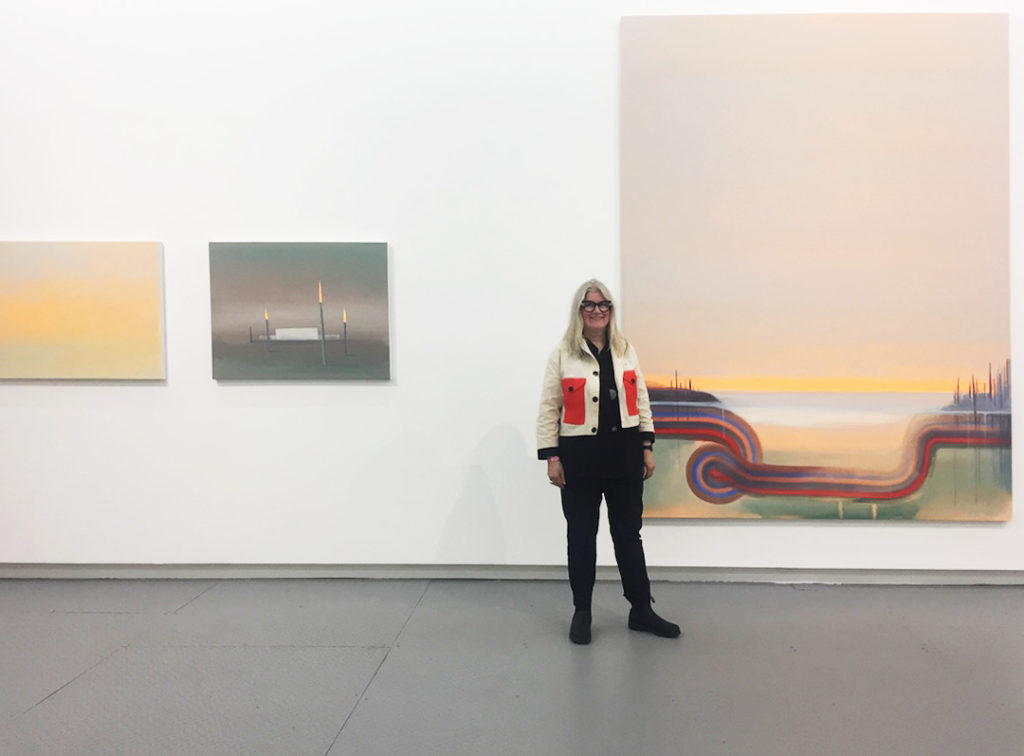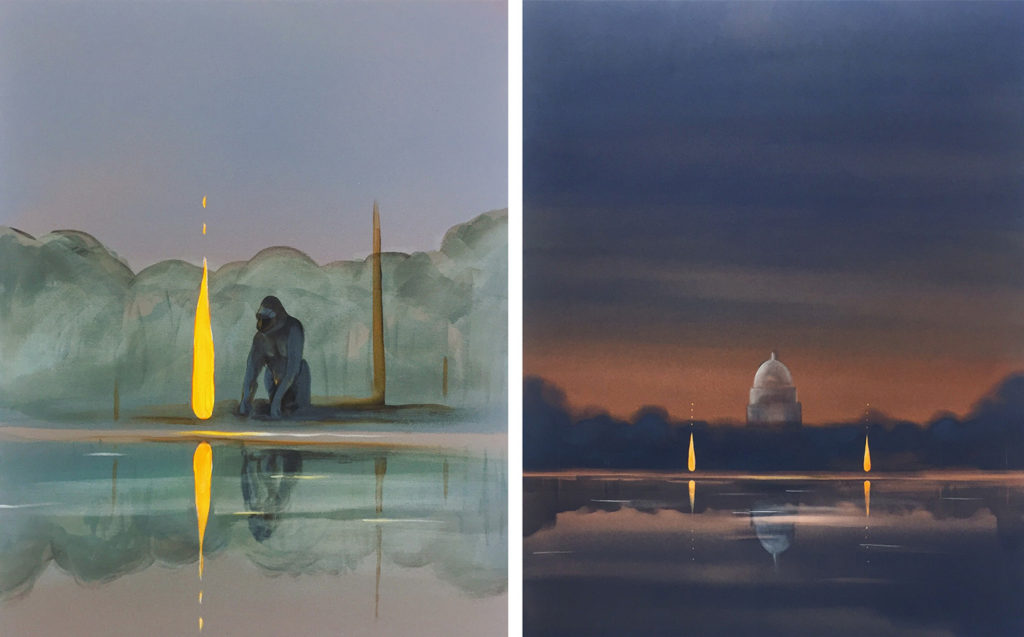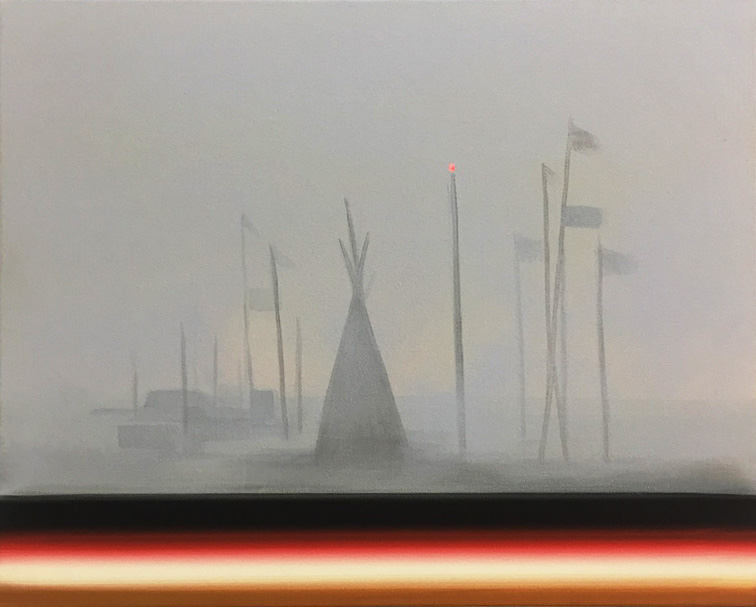
Wanda Koop, “Standing Withstanding” at Arsenal Contemporary, New York, on view until June 17, 2018. Photograph by Katy Hamer, 2018
Artist Wanda Koop paints in a very lyrical way. She let’s the paint dictate the painting, not completely dissimilar from The Composition Series by Kandinsky. Using acrylic in a watered-down format, Koop has been making work for forty years. In that time, she has inherently studied the medium, how it responds to various surfaces, and how to work in a way that is freeing and uninhibited. She loosens the constraints of materiality, while also being deliberate and specific in her color choices and intention. This isn’t an easy undertaking but then again, what form of painting is? Having spent her life in Canada, Koop is based in Winnipeg, Manitoba where she is highly regarded and has received numerous awards including being appointed a member of the Order of Canada in 2006, and as required of all those who receive the award, she exhibits her membership through a lapel pin she wears on a daily basis. In 2016 she received the Governor General’s Award in Visual and Media Arts. All this said, her last exhibition in New York was thirty-five years ago, that is, until now.
Currently on view at Arsenal Contemporary Gallery, New York, is Wanda Koop, “Standing Withstanding” an exhibition of new paintings and a short video. The paintings vary in size and as with most of her work, have an otherworldly quality, in this case presenting a series of subtle landscapes that may or may not exist. Nestled at her studio in Winnipeg, Koop often takes inspiration not only from the world in which she lives, but also current events, particularly how they are presented in the news and on tv.Koop is fascinated with the simplified shapes and divorce of information associated with a bad service in technology and many of her paintings are based on photographs taken from the screen; T.V. or computer. She is highly sensitive to issues of war, refugees, and in this recent body of work, the Keystone Pipeline. The pipeline which is owned by the TransCanada Corporation, and travels through the United States, became an issue of contention when in 2015, President Obama put a hold on the expansion project of the pipeline as in its fourth stage of expansion, was meant to travel through the territories of Indigenous Peoples. In her current exhibition at Arsenal Contemporary, she looks into the pipeline expansion transporting oil from Canada to the United States as it has been extremely controversial even though now, less visible in the news. President Trump approved the expansions of both the Keystone Pipeline and Dakota Pipelines respectively in January 2017. The way she chooses to address this subject, rich in political content, is the same way that she approaches all her painting -with thin washes of color that teeter into the realm of surrealism and abstraction then veer back to representation. She rarely makes direct references to the human body, but there is a figurative presence in her work, sometimes just via the architecture, here, a capital building (that could be from Washington D.C. or Canada) and teepees. There are multiple ways to think about her work and at once the paintings can be entered through the familiarity of large vistas political notations, making timely mentions of current events even if in a conceptual way.

Wanda Koop, from “Standing Withstanding” Left: “Gorilla” Acrylic on canvas, 16″ x 20″, 2018 Right: “Standing Withstanding (Capitol)” Acrylic on canvas, 84″ x 108″, 2018, Photograph by Katy Hamer, 2018
It’s hard to say why Koop hasn’t found the success she has in Canada in the United States, but perhaps the reason is this. She is an artist talking about current events, through photographic references, that are taken and then put away, inspired by watching T.V. This lends itself, whether purposeful or not, to a particular distance in the work. Each blurred brush stroke, seems to be a result of the subject matter that she is tackling and her own dissociation. At once, I was able to accept each painting for what it appears to be on the surface, but when contemplating the various politically inspired references l found myself less engaged. She is, at least in this instance, reacting to something that perhaps through the technique itself, feels disengaged. Some of her references do not seem visually specific enough to differentiate between Canada and the United States, and the symbolism of a capital building, or teepee might be a way of generalizing politics, but does that give us enough to identify the issue at hand? There is a silky quality to the paint but the veins and blood are what lie beneath and even through the entry point of beauty, are mostly inaccessible. Her work appears open, soft, loose and reverent but she wants it to address a particular cultural aesthetic or point of contention beyond. For those who take the time to delve deeper, will they be able to find the artist’s goal in a legible way? Her dedication to the delicacy of the stroke, her resistance of using paint that catapults above the grain, is both a strength and weakness.
“[The work] is more about what I’m trying to say, and finding a way to say it,” said Koop. “In the case of this work, it’s addressing something that is effecting all of us. I’m not trying to be didactic, but I want the paintings to be beautiful so that you personally can interface with them. I can draw, I can paint, I can paint figuratively, it’s not the skill in the end, it’s a vehicle.”
Art must always be more than just a pretty picture or something to look at however, when it is, we need to critically question the choices that the artist is making and wonder if these decisions best suit their agenda. The exhibition also features a short looping video of an albino gorilla, in captivity, frolicking in a pool. The gorilla almost seems to be an avatar for the artist, a beautiful figure in the studio, unique yet also somehow constrained. That said, her lack of visibility in the United States could also just be a part of the numbers game. Canada has a smaller population that the U.S. does, that means there are less artists. The United States, specifically the New York area, is swarming with artists. This dynamic fact means that not all the artists based in New York will receive the acknowledgement that they deserve and this falls onto the shoulders of artists living and working abroad, specifically female artists.

Wanda Koop, “Standing Withstanding (North Dakota” Acrylic on canvas, 20″ x 16″, 2017, Arsenal Contemporary, NY, Photograph by Katy Hamer, 2018
Painting is one of the most difficult of art-making pursuits. The past relates to the present, and what is made in the present will directly effect the future. Even with a cool and purposeful distance, the artist’s fingerprint lies on the surface. If an artist is not on the frontlines of war, can they still tackle this theme? Yes, however, the most direct or effective way to share a particular message, even if with subtle intention, is to metaphorically undress. The insecurities of self-exposure contain truth, even in the most understated strokes.
One way that she has embarked on philanthropic venture outside of her own practice is through Art City. In 1998, Koop founded Art City, a community arts center geared towards youth that offers art programming free of charge. They have a rigorous schedule of programming and are always looking for donations, please visit Art City’s website for more information.
Wanda Koop, “Standing Withstanding” is on view at Arsenal Contemporary until July, 1, 2018.
________________________________________________________________________________________________________
Katy Diamond Hamer is the Founding Editor of Eyes Towards the Dove a platform on contemporary art and culture. She writes for several print and online publications and has done public speaking on numerous occasions. For more of her writing and art life travels, follow her on Instagram @katyhamer
